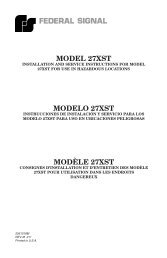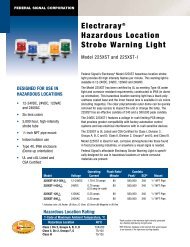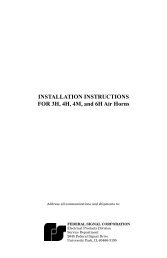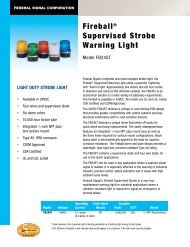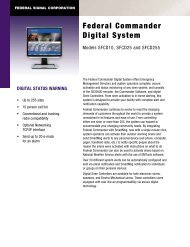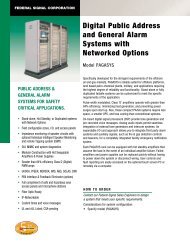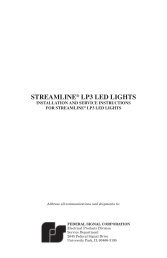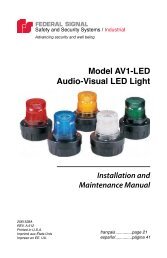UltraVoice Manual - Alerting & Notification
UltraVoice Manual - Alerting & Notification
UltraVoice Manual - Alerting & Notification
Create successful ePaper yourself
Turn your PDF publications into a flip-book with our unique Google optimized e-Paper software.
with a local laptop computer running<br />
SFCDWARE.<br />
A. Operation<br />
The results of a Quiet Test can be<br />
obtained remotely using the SS2000<br />
printout or the SFCDWARE control and<br />
status monitoring software. The status<br />
can also be obtained locally at the siren<br />
site with a portable computer running<br />
SFCDWARE. The actual amplifier<br />
voltage and current are monitored with<br />
Quiet Test providing a true indication of<br />
each amplifier and load performance.<br />
Calibration of the Quiet Test can be<br />
performed by pressing switches 2 & 3<br />
on the front panel at the same time.<br />
Prior to performing a calibration the<br />
speakers must be known good, as per<br />
maintenance section.<br />
B. Finding Faults<br />
The siren automatically will do a reset<br />
when running a Quiet Test. Reset prior<br />
to a Quiet Test is not required. After a<br />
test, the siren must be polled from the<br />
SS2000. The SS2000 printout will<br />
indicate the present siren status.<br />
When using SFCDWARE, the controller<br />
will automatically update the Quiet Test<br />
status each time a new Quiet Test is<br />
run. The status can be obtained from<br />
the status detail screen and from the<br />
Reports menu.<br />
Federal Signal <strong>UltraVoice</strong><br />
Installation and Operation <strong>Manual</strong><br />
OPTIONS<br />
70<br />
8.3 Digital Voice<br />
When purchased, the Digital Voice<br />
option adds a unit that is capable of<br />
playing up to 1000 minutes of prerecorded<br />
messages in any sequence<br />
from 250 messages stored in an SD<br />
Micro FLASH memory card that plugs<br />
into the controller.<br />
The digital voice messages will sound<br />
best if recorded at the native sample<br />
and bit rate rather than converting. The<br />
sample and bit rates are; 8 kHz sample<br />
rate, 8 bit, mono, with the level set so<br />
that the peaks are at or slightly into the<br />
limits.<br />
These messages must be saved with a<br />
DV#.wav naming format. The messages<br />
will not be recognized otherwise. This<br />
naming format will result in messages<br />
DV1.wav through DV250.wav .<br />
Converting files can cause noise.<br />
If converting;<br />
First; adjust the amplitude to insure that<br />
the peaks are at or slightly into the<br />
limits.<br />
When converting from 16 to 8 bit, insure<br />
that “Dithering” is disabled.<br />
After conversion;<br />
Run Amplitude Dynamics Processing<br />
with flat gain for anything above -40 dB<br />
and eliminating anything -40 dB or less.<br />
The Digital Voice system can be<br />
activated by using the radio receiver or<br />
the siren controller panel switches. To<br />
program activation codes with Digital<br />
Voice Messages under them; follow the



